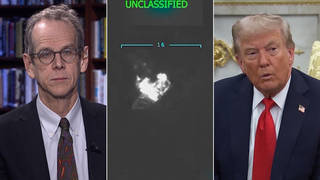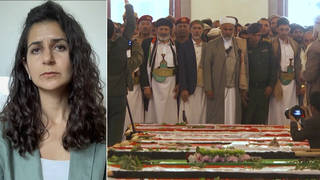
Topics
Guests
- Iona Craigjournalist who was based in Sana’a from 2010 to 2015 as the Yemen correspondent for The Times of London. She was in Yemen again last month, where she reported on January’s Navy SEAL raid that left 25 civilians and one U.S. Navy SEAL dead.
Independent journalist Iona Craig recently traveled to the Yemeni village where the U.S. Navy SEALs conducted a raid in January that left 25 civilians and one Navy SEAL dead. White House Press Secretary Sean Spicer described the raid as “absolutely a success,” but Yemeni villagers who spoke to Craig painted a very different picture.
Transcript
AMY GOODMAN: Iona Craig, I wanted to ask you about the Navy SEAL raid in Yemen in January that you’ve investigated, the White House warning journalists and lawmakers last month against criticizing the botched raid by U.S. commandos on a Yemeni village that left 25 civilians and one U.S. soldier dead, William Ryan Owens. The Bureau of Investigative Journalism reports the January 28th assault killed nine children under the age of 13, with five other children wounded. Among those critical of the raid was Arizona Republican Senator John McCain.
SEN. JOHN McCAIN: When you lose a $75 million airplane, and, more importantly, American lives are—a life is lost, and wounded, I don’t believe that you can call it a success.
AMY GOODMAN: White House Press Secretary Sean Spicer lashed out at Senator McCain and journalists for criticizing President Trump’s decision to order the raid.
PRESS SECRETARY SEAN SPICER: It’s absolutely a success. And I think anyone who would suggest it’s not a success does disservice to the life of Chief Ryan Owens. He fought knowing what was at stake in that mission. And anybody who would suggest otherwise doesn’t fully appreciate how successful that mission was, what the information that they were able to retrieve was and how that will help prevent future terrorist attacks.
KRISTEN WELKER: But even Senator John McCain—
PRESS SECRETARY SEAN SPICER: I understand that. I think my statement is very clear on that, Kristen. I think anybody who undermines the success of that rage [sic] owes an apology and a disservice to the life of Chief Owens.
AMY GOODMAN: So, that is Sean Spicer. President Trump, when he addressed a joint session of Congress, brought in the widow of Ryan Owens, but Ryan Owens’ father, William Owens, refused to meet with President Trump when his son’s body was brought to Dover Air Base, harshly critical of this raid, saying, “Why did he have to do this now, to move so quickly in his administration?” That was one Navy SEAL, and then you have the number of civilian casualties, women and children. What did you find, Iona?
IONA CRAIG: Well, really, the civilians that I spoke to when I went to the village had exactly that same question: Why? Why did the Trump administration choose to carry out this raid? For what reasons? And what are they going to do about it now? Because not only did they put the lives of Navy SEALs at a huge amount of risk, which was highly predictable if you had even a vague understanding of the local politics in that particular area of Yemen at the time, but obviously caused mass civilian casualties. There were 26 people in that village who were killed. As you’ve already mentioned, many of those were women and children. That village has essentially been abandoned now, because not only—after that raid happened, not only was the entire village strafed and more than 120 livestock were killed, but the U.S. went back a month later, at the beginning of March, and bombed it for four consecutive nights, both with drone strikes and helicopter gunfire, and killed two more children and several more adults. So the last person that I spoke to who was living there, Sheikh Aziz al Ameri, he then left the village and is now living under trees several miles away.
So, the impact on the local population, who were essentially on the same side as U.S. in the civil war in Yemen at the moment—they were fighting against the Houthis, which is exactly what the U.S. has been doing over the last two years—they’ve not only alienated the entire local population around there, but caused to huge amount of anti-American sentiment. And now tribesmen, who were not al-Qaeda, who are not even al-Qaeda now, but were not before, but are now quite willing and wanting to fight the Americans as a result of this and a result of them killing their children and their wives.
So, I think that what was quite clear before they even went in there was that, and what actually happened was the fact that, all of the local tribesmen in that area came to defend the village when the U.S. Navy SEALs went in there. And that was because they thought the village was being raided by the people they’d been fighting for the last two-and-a-half years, which is the Houthis. They had no notion that it was Americans that were coming in to attack the village when it happened. And that was quite clearly a huge risk when the Americans went in there to carry out this raid, that that would indeed happen. It’s the middle of a civil war. That village is right behind the front lines. They had been receiving rocket fire and mortar fire from their opponents in the civil war in the days and weeks before the raid. So, of course it was their assumption that their village was being stormed by the Houthi rebels, whom they’ve been fighting for so long. So, every man within hearing distance of gunfire came running. I spoke to a man who drove 45 minutes from his neighboring village when he got the call to come and help defend his neighbors’ area. And so, I think the risk to the Navy SEALs was massive before they even went in there. It appears that there had been at least some knowledge within the village that they were in fact coming, as well. And so, for all those reasons, the Navy SEALs were being put under a huge amount of risk, and it was highly likely that somebody was going to—one of their team was going to get killed, not to mention then the fact that they inevitably got pinned down by fire, then had to call in air support and basically decimate the entire village in order to be able to extract themselves safely from that situation. And from what I saw, and talking to people, most of that was predictable before they even went in there.
NERMEEN SHAIKH: Well, Iona Craig, as you report in the piece, White House spokesperson Sean Spicer said the purpose of the raid was intelligence gathering and not specifically targeting anyone, and that initially the U.S. Central Command posted a video backing Spicer’s claim, but that video was subsequently removed when it was proven that it was 10 years old.
IONA CRAIG: Yeah, I mean, two things on that front. Certainly, from what I was told and in addition to statements that appear to have come out from the military since then, they were in fact going after the leader of al-Qaeda in the Arabian Peninsula, a man called Qasim al-Raymi. I think it’s extremely unlikely that they would have been carrying out such a high-risk mission in order to gather laptops, cellphones or intelligence, as they suggest. He was not in the village and, in fact, released an audio statement mocking both Trump and the raid several days later. Although there were some low-level al-Qaeda militants there in one particular house, because of the situation of how the Navy SEALs came under fire, that house was in fact bombed by an airstrike before the SEALs could even get into it, so whatever intelligence they claim to have gathered from there would have come from other buildings where there were no al-Qaeda militants present.
That video that you mentioned, that was—when it was first posted, was labeled as an AQAP—so that’s al-Qaeda in the Arabian Peninsula—video of how to make bombs, as you say, was—had turned out was 10 years old, had already been available on the internet. Well, AQAP, as it is now, didn’t even exist 10 years ago, so even to label it as an AQAP video was kind of laughable, really. And if that’s the best of the intelligence that came out of there, then it seems that that was a very high-risk undertaking for very little gain, if that’s the best that they can show for it.
But as I mentioned, certainly, the people I spoke to on the ground, when I asked them about what houses the Navy SEALs got into or perhaps access to the dead bodies, who may have been carrying, let’s say, cellphones or electrical equipment, they couldn’t even clarify to me that the Navy SEALs had got inside buildings or had actually access to the dead. They couldn’t say either way, because of the chaos of the situation, it being extremely dark. They obviously didn’t have night vision goggles like the Navy SEALs would have. So it wasn’t even clear that they had in fact got into any buildings or not. So I think that’s highly disputed, that intelligence. And certainly, some of the claims being made over the last few days, that the whole laptop ban was linked to intelligence gathered from the Yemen raid, do not add up at all, from what I’ve seen being written in the media on that, as well.
AMY GOODMAN: Iona, we have less than a minute to go, but earlier this month Amnesty International urged Trump to block future arms sales, writing, “Arming the Saudi Arabia and Bahrain governments risks complicity with war crimes, and doing so while simultaneously banning travel to the U.S. from Yemen would be even more unconscionable,” Amnesty wrote. A front-page story in The New York Times today, “Secretary of State Rex Tillerson has decided to lift all human rights conditions on a major sale of F-16 fighter jets and other arms to Bahrain in an effort to end a rift between the United States and the critical Middle East ally.” If you can, very quickly, talk about the role of U.S. weapons in these conflicts?
IONA CRAIG: In Yemen, it’s huge. The U.S. is the biggest exporter to Saudi Arabia, and it’s big business for the U.S. But, of course, we know that the majority of civilian casualties in the war in Yemen have been caused by Saudi-led airstrikes. And the U.S. has a huge influence over this. They were—those precision-guided weapons were suspended at the end of last year, and now we’re looking at a resumption of that, where the U.S. does actually have influence over Saudi Arabia—not just over Saudi Arabia, but also the continuation of this war, for the weapons that it sells to them and to the logistical support it gives to the Saudi-led coalition in the terms of refueling and in the terms of targets, as well.
So, this is—it is, obviously, worrying for those people and campaigners who have been trying to prevent the sale of weapons to Saudi Arabia, but also the terms of those sales. There are indications now that those weapons may be sold under commercial terms rather than under military, which also then doesn’t attach the same end use issues with them, so there isn’t so much scrutiny then with the end use of those weapons in a war like Yemen. And that’s also deeply concerning. So, I think now, at a stage where really the attempt should be made to de-escalate the conflict, it’s—all indications are now that, in fact, the war in Yemen will be escalated by the activities of the U.S. government right now.
NERMEEN SHAIKH: Well, one last, very quickly, Iona, that we—as we said in our introduction, there have been more airstrikes carried out since the start of 2017 than there were in all of 2016. But you’ve pointed out in a recent interview that there were more drone strikes in Yemen over the space of 36 hours than there were in all of 2016.
IONA CRAIG: Yes, absolutely. And even in the last 24 hours, there have been U.S. airstrikes—and not just airstrikes, there’s naval bombardments, as well, which, of course, were being done under the Obama administration, but those airstrikes have been carried out in Abyan province, in Shabwah, in Hadhramaut, in Ma’rib—in the last 24 hours in Ma’rib, in Shabwah and in Abyan, and also in Al Bayda, as well, earlier on in March. So, yes, there’s definitely—there’s not just this surge at the beginning of March, where we saw that 36 hours of airstrikes happening very rapidly, but that’s been a continuation, as well, now. And as I say, it’s not just drone strikes. It’s airstrikes from fighter jets, and it’s also coming from the sea.
AMY GOODMAN: Iona Craig, we want to thank you for being with us, freelance journalist who was based in Sana’a for years, has continued to go back and forth reporting on what’s happening there. Thanks so much for joining us.
This is Democracy Now! When we come back, the U.S. is leading a boycott of U.N. talks on a nuclear ban. We’ll find out why. Stay with us.












Media Options